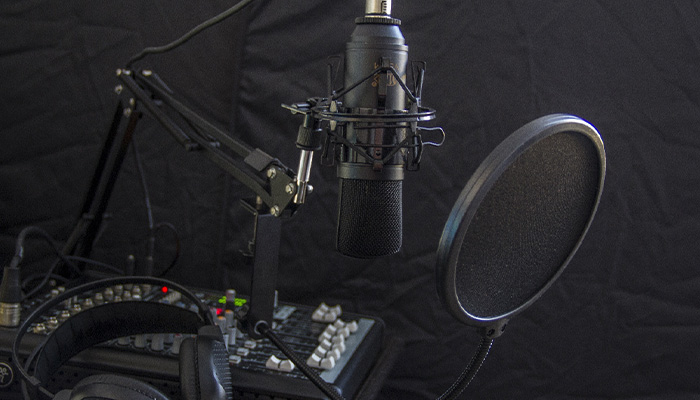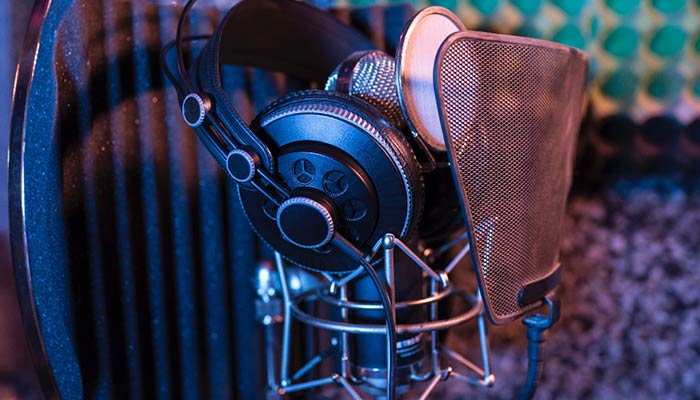Many podcasters and creators worldwide find the sound of their voices to be a real source of concern. If you’ve ever listened to a recording of your normal voice and thought to yourself, “Is that how I really sound?” Short answer, you’re hardly the only one.
Some find their voices too soft, while others find their voice too sonorous. In comparison, you might wonder how to make your voice deeper.
You may have noticed yourself or others talking in a deeper, bolder tone during formal or office situations. Why? They do this because a low, resounding deep voice is associated with strength, authority, and reliability.
It is easy to see why many people yearn for a deeper voice. This is not a feeling specific to men, as many women have sought to deepen their voice to assert themselves or make themselves heard.
For podcasters or YouTubers, voice is everything. Most potential subscribers decide if they want to keep listening to you within the first 15 seconds. Therefore, you need a voice that demands to be heard.
This guide should be helpful if you’re unsatisfied with your voice or wish to improve it like many other people.
The lower tone of your voice is predetermined by the length and thickness of your vocal cords. These vocal cords, once fully developed, seldom change. For the rest of your life, they determine every sound, from the high notes to the lower depths.
Learned behavior is only a minor determinant for the sound of your voice. Patterns of diction, pronunciation, and inflection are continuously picked up from your environment. However, you’ll never learn to sound like James Earl Jones if you don’t have longer and thicker vocal cords. To a large extent, your natural voice is basically limited to what it is.
There are no apparent downsides to having a deeper voice and a lot of clear upsides. If you intend to record your voice for an audience, having a deep voice is objectively better. So how exactly do you make your voice deeper?
All methods to make your voice sound deeper cost time, effort, or money. Some demand all three. Nevertheless, if you’re committed and practice as often as possible, you’ll eventually get the deeper voice quality you desire.
You may find some sources that suggest how to make your voice deeper with elaborate voice exercises that allegedly help you lower the pitch of your voice. However, the bad news is that many of these are either disproven or untested.
The only permanent and confirmed ways to deepen your voice are hormonal therapy and surgery, and those are a bit over-the-top for people who just want a slightly lower pitch.
But even though you can’t physically make your voice lower to the magnitude that you expect, you can give the impression of a more attractive, deeper voice through the use of equipment, programs, or voice training.
Before you can make any meaningful changes to your voice, you have to come to terms with the nature of your voice. That is how you sound, and it’s not going away unless you do something about it.
Listen carefully to the words that are coming out of your mouth and take notes on what you struggle with. Study your pitch, and make recordings of your speech so you can directly compare later. Once you’ve done that, you can choose the method you think will be most convenient for you.

If your voice sounds weak in person, it is likely to sound the same or worse when you use a microphone. It is even possible to be satisfied with your normal voice but end up ruining it with a microphone.
You’ll want to get as much an advantage as possible when you buy a mic. Getting a microphone that records your voice the way you want is a great way to make yourself sound better and enjoy your recording process.
Before buying a mic, you have to make sure it’s the right one for your content. Many people realize too late that there are different kinds of microphones for different purposes.
One important way that microphones differ is in their pickup patterns. Cardioid pickup patterns are most commonly used to record speech. This is because it is good at isolating the background noises and focusing only on the sounds from the front. Read more about the different pickup patterns and their uses here.
If you want to capture sound better, you’re better off getting a condenser or ribbon microphone.
Studios use condenser mics because of their detail and accuracy. These mics are very sensitive to the sounds in front of them, making them suitable for amplifying and deepening your speaking voice. Condenser microphones come with either a large diaphragm or a small one. Larger diaphragms are better at producing a deeper voice.
Optimally, you should consider getting a condenser cardioid microphone as they are sensitive and give a strong, crisp sound.
Even if you don’t intend to get a condenser mic and you get a dynamic or shotgun mic instead, you should opt for one with a cardioid polar pattern.
Voice-altering software has been popular for a while. This is because of many software’s abilities to distort your natural voice and make you sound like anyone or anything you want.
As a testament to their effectiveness, they gained popularity among criminals seeking to communicate without getting caught. If you’re trying to record or stream, these apps can make your voice deeper and fuller.
The downside used to be that these types of software have in-built microphones, which may be of less quality than your preferred mic.
Nowadays, many popular apps just need to access your mic and can manipulate your speaking voice as you wish. Some of these work right as you record or stream. Others require you to edit your audio after recording it. It’s your decision on how you want to work.
Audio plugins are usually used professionally to smoothen out the work of musicians or voice actors or anyone in show business. However, they have also become popular among semi-professionals and amateurs trying to achieve better vocals.
Audio plugins can add depth to your voice and enhance the sound in any way that you want. Through digital equalization, dynamic range control, and pitch shifting (via a phase vocoder), an audio plugin can add vibrancy and color to your voice, making it more presentable. It has the added advantage of being customizable, so you can tweak your voice on the go and adjust as desired.

Sometimes, it’s not you. Your voice can sound bad on a recording for other reasons. One of the foremost reasons is a room or studio with poor acoustic design.
A convergence of reflected sounds can sometimes create high-pitched recordings. Optimizing your room or studio for recording a speech includes getting the room set up properly with acoustic treatment such as bass traps, acoustic panels, or acoustic foams among other solutions.
The goal of acoustic treatment is to make your environment sound more sonically pleasing with controlled ambiance and predictable qualities for recording.
To learn more about acoustic treatment, check out this article.
There are a variety of mobile applications available for smartphones that you can use to train your vocal cords on your own time. These applications allow you to train towards specific goals and to monitor your performance.
Some allow you to measure how deep your voice sounds and let you compare your voice to real-life celebrities with similar-sounding voices. Others take it further and allow you to change the sound of your voice in real-time.
There are dozens of these apps available in the app stores on smartphones. All you need to do is find one that works great for you.

Using your microphone properly is a common way to improve vocal depth. By adjusting the sensitivity or gain of your microphone, you gain greater control of your voice.
If you’re using a condenser mic, the distance between the microphone and the singer will have the most significant effect on the tone. The closer you get to a microphone, the boomier your voice becomes. However, you have to be careful not to end up with a muffled sound.
To get the tone you want, position yourself 6 inches away from the microphone, and then move the mic forward or backward until you’re satisfied. It would help if you didn’t go closer than 5 inches, as things can get muddy.
It’s crucial to be audible even as you’re trying to sound bold. Ensure the vocalist looks straight ahead when speaking otherwise you’ll put unnecessary stress on their vocal cords.
With everything digitally controlled nowadays, you don’t have to adjust the recording levels as much as they did back in the 60s and 70s. Regardless, you still have to pay attention to your microphone settings and adjust them to suit your voice.

Pop filters and windscreens are used to reduce or eliminate popping sounds caused by the impact of fast-moving air on the microphone. You use them to get rid of plosives. Plosives come from saying words that start with “P” or “B”, other ‘hard’ consonants.
You can use them to make your voice sound deeper to your audience too. By filtering out noise and creating resonance, the mic can focus on your voice alone.
Most microphones usually come with a pop filter but if your mic does not have one you can buy one for cheap.
To truly deepen your voice, you’ll need to commit to daily vocal exercises that stretch your ability to speak in a lower pitch. It takes three to four weeks before you start to hear marginal differences in depth. You’ll need to practice reading slowly with a low voice every day while paying rapt attention to any changes.
You also have to commit to warm-up exercises before putting any stress on your voice, especially if you are singing and want to make your voice deeper.
Humming, for example, allows you to warm up your voice box so you can have more control over your voice. Hum often, and you’ll be able to lower your voice’s pitch, talk a bit deeper, and eventually make your voice sound deeper on mic or video.
Other warm-up exercises include: yawning, sighing, straw vocalizing, lip buzzing, tongue trills, loosening the jaw, two-octave glides, sirens, and slides.
Unsurprisingly, what you put down your throat can influence the sound and delivery of your voice.
Drinking fluids are a good way to enhance your voice, as they keep your voice box lubricated. Make sure to drink plenty of water if you plan to do a lot of speaking.
Hot tea is also good for the voice, and if it contains any mint or chamomile, it provides the extra advantage of relaxing your muscles. The heat causes an influx of blood to your voice box and makes your vocal cords larger.
Cantaloupes and other melons are about 90% water so they can help in case you need to lubricate quickly.
Milk and other dairy products cause mucus buildup in your throat and can hamper your vocalization.
Alcohol tends to dehydrate you, which could shrink your vocal cords and make your voice higher.
Citrus fruits and juices have a similar effect. Due to their acidic nature, they draw out water from your body and can dry up your vocal cords.
Caffeine affects your voice for the same reason as alcohol so you should avoid it before recording.
Bacon affects vocal cords, which makes sense since it is incredibly salty. Salty foods draw out moisture from the body, so they must be avoided to keep your hydration levels high and your voice clear.
Many online resources that promise to change your voice actually end up causing long-term damage to your vocal cords. To get the best results without any damage, it helps to work with a professional vocal coach that can show you how to make your voice deeper.
Learning to pace your voice gives you better control and room for depth. Pacing allows silence between words so you can spread them out and focus on your vocal tone.
Depth aside, pacing also tells a lot to your listeners. It determines how they receive information. Speaking at a faster pace conveys excitement or urgency. On the other hand, a slow place emphasizes detail and communicates that your message is important.
Your change of pace is perhaps one of the most significant changes you can make. The audience will quickly get overwhelmed if you speak fast all the time but may get bored if you talk slowly all the time. If you pace yourself properly, you can sustain your audience’s attention while being in control of your depth.
In high-stress situations, the pitch of your voice goes up, and you may be less articulate. In these situations, you may need to find ways to maintain calmness. You can easily stress vocal cords, but you can also relax them. Studies show that meditation and breath control improve vocal control.

Most people ignore their diaphragm entirely and try to use their chest alone. The problem is that they put too much pressure on the chest and lower respiratory system, and therefore they can’t hold a lot of air. This can make your voice weak, raspy, and high.
If you do this, you should try the simple exercise of breathing from your diaphragm. The diaphragm is a thin band of muscle at the bottom of your lungs that stretches towards your belly when you breathe, at least when you do it properly.
Practice breathing from your belly every day.
Over time, you’ll develop a habit of breathing that way subconsciously. As a result, you’ll be able to speak better and with less rasp on the low end of your vocal register. Less rasp means a less high-pitched voice.
When we produce sound, we need a way to naturally amplify or refine the sound, in a sense. We call this resonance. Most people resonate their voices in their nasal cavity, giving it a “nasal” tone. This can be an unattractive and shrill sound. To avoid this, get more resonance from your chest instead.
Inflection describes various changes in your voice when speaking—using the proper cues while speaking can communicate assertiveness as well as any change in depth.
Upward inflection is a change in pitch from a lower to a higher note, specifically in a vowel. Most often, this change in pitch indicates questioning, uncertainty, surprise, or suspense.
Downward inflection is a change in pitch going from high to low notes again, specifically within the vowel. A downward inflection at the end of a sentence makes it more authoritative and tells the audience you know what you’re talking about.
Medical and surgical intervention is a bit of a wild card here. Voice masculinization therapy is conceptually a solution, but it’s really only used for transgender people with voice problems. Tinkering with hormones can come with unintended consequences.
Surgery is a little more common among cis people looking to change their voices but it is invasive, a little dangerous, and very expensive. It definitely works though. You’ll get a much deeper voice, but you’ll need deep pockets.
Lastly, it is essential to point out that all these options require a lot of patience and effort. Finding the right solution on how to make your voice deeper may take time, but in the end, you’ll be glad you put in the work.